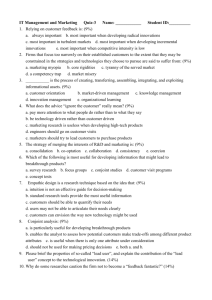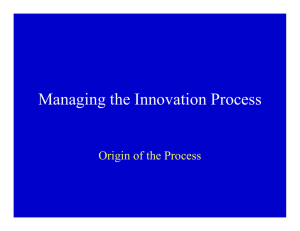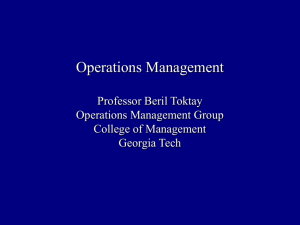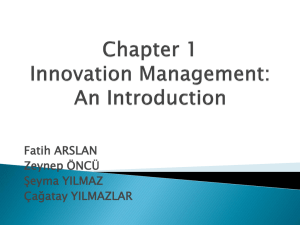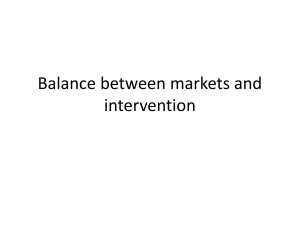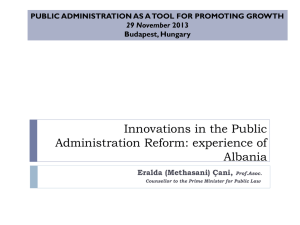Slides: Chapter 1: Nature of Innovation
advertisement
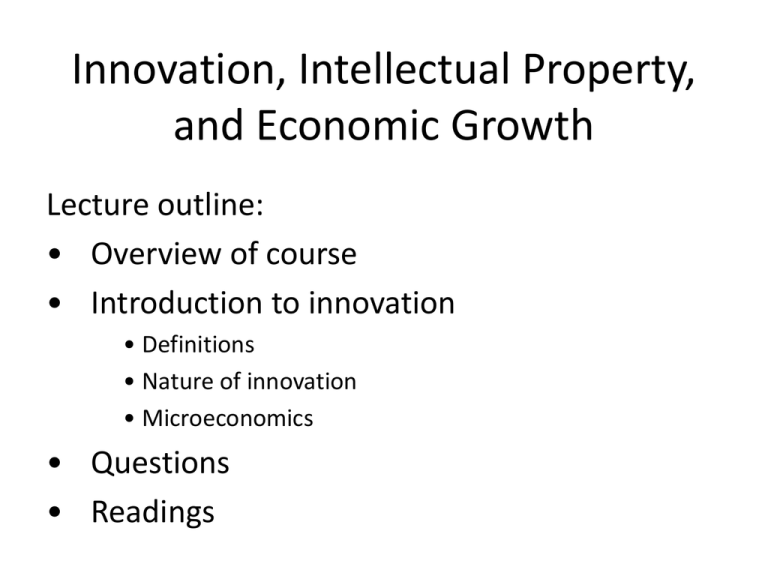
Innovation, Intellectual Property, and Economic Growth Lecture outline: • Overview of course • Introduction to innovation • Definitions • Nature of innovation • Microeconomics • Questions • Readings Overview of course • • • • Details of course Teaching Resources Assessment What is course about? • Applying economic analysis to the understanding of the innovative process • Determinants • Consequences • Market failure (are optimal resources devoted to innovation) • Some key questions • • • • • What drives innovation? How does intellectual property influence innovation? Which market structures yield more or better innovations? Why are some countries rich and some poor? Is economic regulation good or bad for innovation? What is the ‘economics of innovation’? Microeconomics – understanding processes, including how incentives affect firms Macroeconomics – ‘innovation’ drives economic growth.. and economic growth drives living standards, environmental, political… Economic Policy – are there market failures in the innovation process and what, if anything, should the government do? Business Strategy – this is not a course on advising firms how to innovate, but does include some insight into this Definition of innovation Basic definition Introduction of new ideas that add ‘value’ to a firm’s activities OECD The Oslo Manual (1997, p.28) • introduction of a new product or a qualitative change in an existing product • process innovation new to an industry • the opening of a new market • development of new sources of supply for raw materials or other inputs • changes in industrial organisation Innovation and business Some students may benefit from a brief comment on why innovation is so important to business Some example of quotes • "Business has only two functions, innovation and marketing." Peter F Drucker • “Creativity is thinking up new things. Innovation is doing new things.” Theodore Levitt (management guru) • Innovation distinguishes between a leader and a follower.“ Steve Jobs The innovation process AGENTS EXTERNALOR FIRM-LEVEL INITIATIVES ACTIVITIES Basic research OUTPUTS Discoveries Ideas MARKET-LEVEL PROCESS FIRM-LEVEL INITIATIVES Applied research Information collation Inventions Blueprints Plans Development Testing Prototypes Beta-versions Investment Innovation (product or process) Adoption or purchase decision Market penetration Adaptation Improvement STAGE RESEARCH AND DEVELOPMENT 1 2 Figure 1.1 Greenhalgh and Rogers (2010) 32 COMMERCIALISATION DIFFUSION 4 5 Invention, Innovation, Diffusion (Schumpeterian trilogy) • Invention: creation of an idea to do or make something (profitability not yet verified) • Innovation: new product/ process commercially valuable i.e. successfully developed inventions. • Diffusion: the spread of a new invention/innovation throughout society or at least throughout the relevant part of society. – Without this cannot gain full benefits – Some of this represents ‘spillovers’ or ‘positive externalities’ Scientists, Knowledge and Technology Scientists • Discover knowledge by research • Disseminate knowledge (open science?) • Knowledge is public good(non-rival in use), hence created externalities • Universities, government labs, some large firms • It may represent the basis for technological advances Technology • Application of knowledge to ‘production’ • Firms driven by profit incentive • Private good: investment (R&D) projects, appropriate, use of intellectual property Product and process innovations Product innovations • product used by consumers • • Microwaves, computers, mobile phones, etc Products use by firms • Shipping containers, computers, robots, etc Process innovations • Used by consumers • • Fast food, air travel Used by firms • Assembly lines, software Defining an innovation • Can be defined as new to – Firm – Market (industry) – World • No universal agreement of which • Radical vs incremental – Radical (steam, internal combustion engine, computers, internet) – Incremental (constant improvements) – Both important in driving economic growth Further ideas • Can extend the introduction by considering – Further examples of specific innovations, including cases studies of famous innovations – Look at country / state / city comparisons of innovativeness – Can provide overview of productivity, economic growth, etc Microeconomic effects of innovation • Following slides could be part of introduction or separate lecture – Can expand formality of this topic, including introducing maths-based questions relating to consumer surplus changes, optimal subsidies, public goods Figure 1.2 Process innovation in perfectly competitive market Price (p) Initial consumer surplus MC1=AC1 P1 P2 MC2=AC2 demand curve Q1 Q2 quantity (Q) Figure 1.3 Process innovation for a monopoly Price (p) P3 P4 MC1=AC1 MC2=AC2 demand curve Q3 Q4 quantity (Q) marginal revenue (MR) Figure 1.4 New product demand curve Price (p) P1 a b c d e MC1=AC1 new demand curve Q1 Q* quantity (Q) marginal revenue (MR) Figure 1.5 A product innovation represented by a shift in existing demand curve Price (p) pnew Dnew pold Dold qold qnew MC=AC Quantity (q) Innovations and Market Failure • Innovation as a public good – Non-rival and non-excludable • Externalities from innovative activity – R&D spillovers • Indivisibilities, uncertainty, and capital markets – Fixed costs, uncertainties – Do capital markets cope with these? • Patent races and duplication Restoring incentives to invent and innovate • • • • • Public provision of a public good Club provision of a local public good Pigovian subsidies Definition of property rights The trade-off between incentives and monopoly power Subsidies for R&D Questions for discussion 1. 2. 3. 4. 5. 6. How would you distinguish between an invention and an innovation? What are the key characteristics of a public good? Is all new knowledge a public good? What is a positive externality? How does this differ from a public good? How does innovation create positive externalities? Why are they a problem? What are the key market failures surrounding investment in innovation? Does the creation of intellectual property rights help or hinder the markets for innovative goods and processes? References • Key textbook for this course is – Greenhalgh, C and Rogers, M (2010) “Innovation, Intellectual Property and Economic Growth”, Princeton University Press • For this week read Chapter 1 • Future lectures will follow each of the chapters of the book • Additional articles will be given each week
